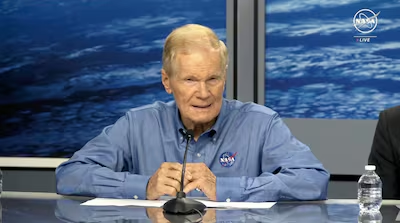A SpaceX spacecraft will be used to return two astronauts who have been stuck on the International Space Station since June, after their troubled Boeing Starliner capsule suffered a series of technical glitches.
US space agency Nasa revealed the plans to return Suni Williams and Butch Wilmore to Earth during a press conference at the Johnson Space Centre in Houston on Saturday.
A technical issue with the Boeing Starliner's thrusters meant that the astronauts were unable to leave the ISS following what was planned as an eight-day mission.
Nasa says both astronauts will now return in February 2025 on board a SpaceX Craft Crew Dragon.
The Boeing Starliner will undock from the ISS without a crew and attempt to return to Earth as it would have with astronauts aboard.
Nasa administrators said the decision was made as uncertainty over the thrusters left an intolerable level of risk.
Nasa chief Bill Nelson admitted the decision had been difficult, but said it was made due to a commitment to safety.
"Space flight is a risk, even at its safest and even at its most routine, and a test flight, by nature, is neither safe nor routine," he said.
"Our core value is safety and it is our north star."

Mr Nelson stressed that Boeing had worked closely with Nasa around the astronauts' return, adding that Starliner remained in the agency's future plans.
“I'm grateful to Nasa and Boeing teams for their detailed and incredible work to get to this decision”, he added.
However, Nasa administrators also revealed that a “technical disagreement” existed between Nasa and Boeing engineers over the level of risk to the ISS astronauts.
Starliner's propulsion system suffered a series of glitches beginning in the first 24 hours of its flight to the ISS, sparking months of cascading delays.
Five of its 28 thrusters failed and it also suffered leaks of helium, which is used to pressurise the thrusters.
In a rare reshuffling of Nasa's astronaut operations, the two astronauts will return on a SpaceX Crew Dragon spacecraft due to launch next month as part of a routine astronaut rotation mission.
Two of the Crew Dragon's four astronaut seats will be kept empty for Mr Wilmore and Ms Williams.
Nasa associate administrator Jim Free said: “Our focus is on safety all the time. The uncertainty remains in the safety of out thrusters. This has not been an easy, decision but is the right one.”
Boeing struggled for years to develop Starliner, a gumdrop-shaped capsule designed to compete with Crew Dragon as a second US option for sending astronauts into Earth's orbit.
Starliner failed a 2019 test to launch to the ISS uncrewed, but mostly succeeded in a 2022, attempt where it also encountered thruster problems.





